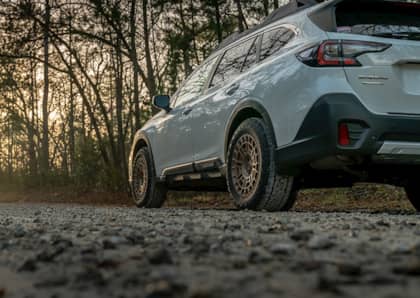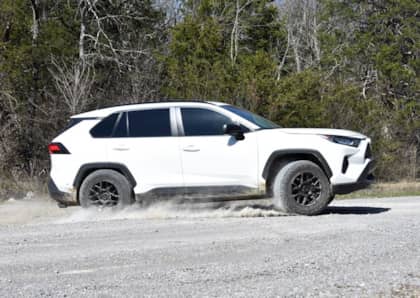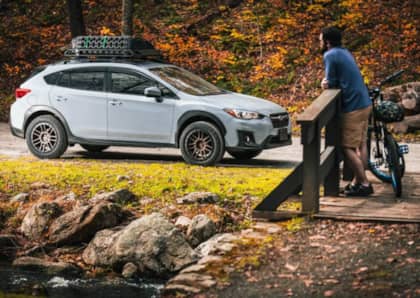How To Get Maximum MPG Out Of Your Crossover Utility Vehicle (CUV)
You bought a crossover utility vehicle based on its versatility and efficiency advantages over a full-size SUV. Now, with gas prices over $4 a gallon, tough decisions have to be made. Do you park your daily driver or continue to eat the high costs of refueling? Do you try to replace your crossover with something more fuel efficient in the current (insane) car market? Or is it time to awkwardly car pool with a co-worker? We didn’t think so. It’s time to squeeze every last bit of mileage out of your CUV.

Believe it or not, there are seven easy—and near-free—ways to extend your range between fill ups. It all starts with your connection to the road. Tires, tires tires! Beyond that, reducing engine rpm, the vehicle’s wind drag and eliminating idling wherever possible can all contribute to noticeable increases in fuel economy. For detailed instructions on how to make it happen, keep scrolling. Maximizing your efforts to reduce fuel consumption behind the wheel will culminate in minimizing your losses at the pump.
$4+ A Gallon—"The New Normal”

As unpredictable as life is, one thing is for certain right now: especially with the summer months coming (i.e. travel season), gas is $4 per gallon and won’t be dropping anytime soon… For those of you who commute to work, paying double what you used to to fill up the same car leaves an indefinite dent in your disposable income. To minimize this loss, we’ve compiled a list of seven different means of adding precious tenths to your mpg number. The best part is that nearly every one of them is free. The only cost a do-it-yourselfer will likely face is the price of checking the balance of his or her tires, should they choose this insurance measure.
1. Proper Inflation Pressure

Before any other mpg-boosting measure is taken, have a look at your tires. First, keep regular tabs on inflation pressure, ensuring that all four of them are set the same. Remember, a tire can lose 1 psi per month due to permeation alone, not to mention that pressure loss can increase in colder weather. On top of hindering peak fuel economy potential, under-inflated tires can experience excessive wear on their shoulders. Take care that you add pressure when the tires are cool (not warm or immediately following a drive) for utmost accuracy in airing up, and also make sure you don’t over-inflate them. Over-inflation can lead to excessive tread wear on the crown of the tire.
2. Regularly Scheduled Tire Rotations

Keeping your tires rotated ensures even tread wear. That means maximum tire longevity, but also a smoother, safer ride for peak tire performance. For optimum tread wear, adhere to the tire rotation interval specified by the vehicle manufacturer, and also rotate using the manufacturer’s recommended rotation pattern. Lastly, recheck inflation pressure after a tire rotation. Once again, the importance of proper inflation pressure can’t be stressed enough.
3. Make Sure Your Tires Are Properly Balanced

Most car owners pay for the initial mount and balance at the time they purchase their tires but they never see a balance machine again. However, very few drivers are aware that their tires’ balance should be checked at each rotation interval. Your tires may not need to be rebalanced at that time, but they should at least be checked. Fortunately, when a true balance issue arises it’s immediately apparent to most drivers. If you experience any side-to-side vibration or wobbling felt in the steering wheel, or a vertical vibration or hop—get your tires rebalanced ASAP. Albeit slight, either of the latter scenarios can have an impact on fuel economy. You want your tires tracking true and smooth at all times.
4. Slow Down!

You don’t really need to go 85 mph on the freeway, do you? Don’t clog traffic, but back things down to 75 mph, if not 70 mph and you’ll likely see a noticeable increase in mpg. It’s a fact that all internal combustion engines get better fuel economy at lower rpm and with less drag on the vehicle. Also, use cruise control but kill the cruise on hills. The trick is to plan your ascent without the transmission downshifting, raising rpm and causing the engine to consume more fuel. Your plan shouldn’t be to “coast” up a hill, but some loss of speed while climbing a grade is a worthwhile tradeoff if the engine can be kept near the lower operating rpm it sees in Overdrive.
5. & 6. Avoid Hard Acceleration And Don’t Overload Your CUV

Along the lines of slowing down in order to better conserve fuel, you should go out of your way to avoid instances of hard acceleration. Spirited driving saps fuel economy and the more you see your tach needle above 3,000 rpm the more gas you’re going to consume. To be sure, try to keep up with traffic, but definitely stop racing from red light to red light. Additionally, don’t overload your vehicle or drive around with extra cargo onboard. Added weight (no matter how minimal it seems) means more mass to get moving, which ultimately means more gas usage.
7. Don’t Sit And Idle

This one’s easier said than done, but turn off your engine when you can. Don’t idle for an hour unless you need the A/C compressor turning or the heat blasting. Depending on how long you’re sitting, the savings could either be minimal or borderline substantial. It’s said that every hour of idle time can consume between a quarter to a half gallon of gasoline. Above all else, remember that 0 mph is always 0 mpg.
Our Results From Doing All Of The Above

By dropping our interstate speed to 70 mph from 80 mph in our ’16 Toyota RAV4, the results were staggering. We went from just under 27-mpg to the 28.5-mpg average shown on a recent road trip. Granted, we had a few things working in our favor. First, conditions were ideal for maximizing mileage, with little wind and fair ambient temperatures. And thanks to the mild climate, we didn’t need to run the A/C or heat (it’s spring here in the Midwest, so we’re able to get away with this—for now). On top of that, our highway mileage average depicted above—which is the best fuel economy the RAV4 has ever returned—was achieved with 245/65R17 Nitto Nomad Grappler crossover terrain tires, a larger tire that what came stock on the CUV.
Curious to know more about the Nomad Grappler, the tire that’s given us our ’16 RAV4 its best mileage to date? Look no further than our initial impressions of Nitto’s latest tread right here.
More From Driving Line
- Curious to know more about the Nomad Grappler, the tire that’s given us our ’16 RAV4 its best mileage to date? Look no further than our initial impressions of Nitto’s latest tread right here.











